child restraint AUDI Q7 2021 Owner´s Manual
[x] Cancel search | Manufacturer: AUDI, Model Year: 2021, Model line: Q7, Model: AUDI Q7 2021Pages: 332, PDF Size: 117.99 MB
Page 4 of 332
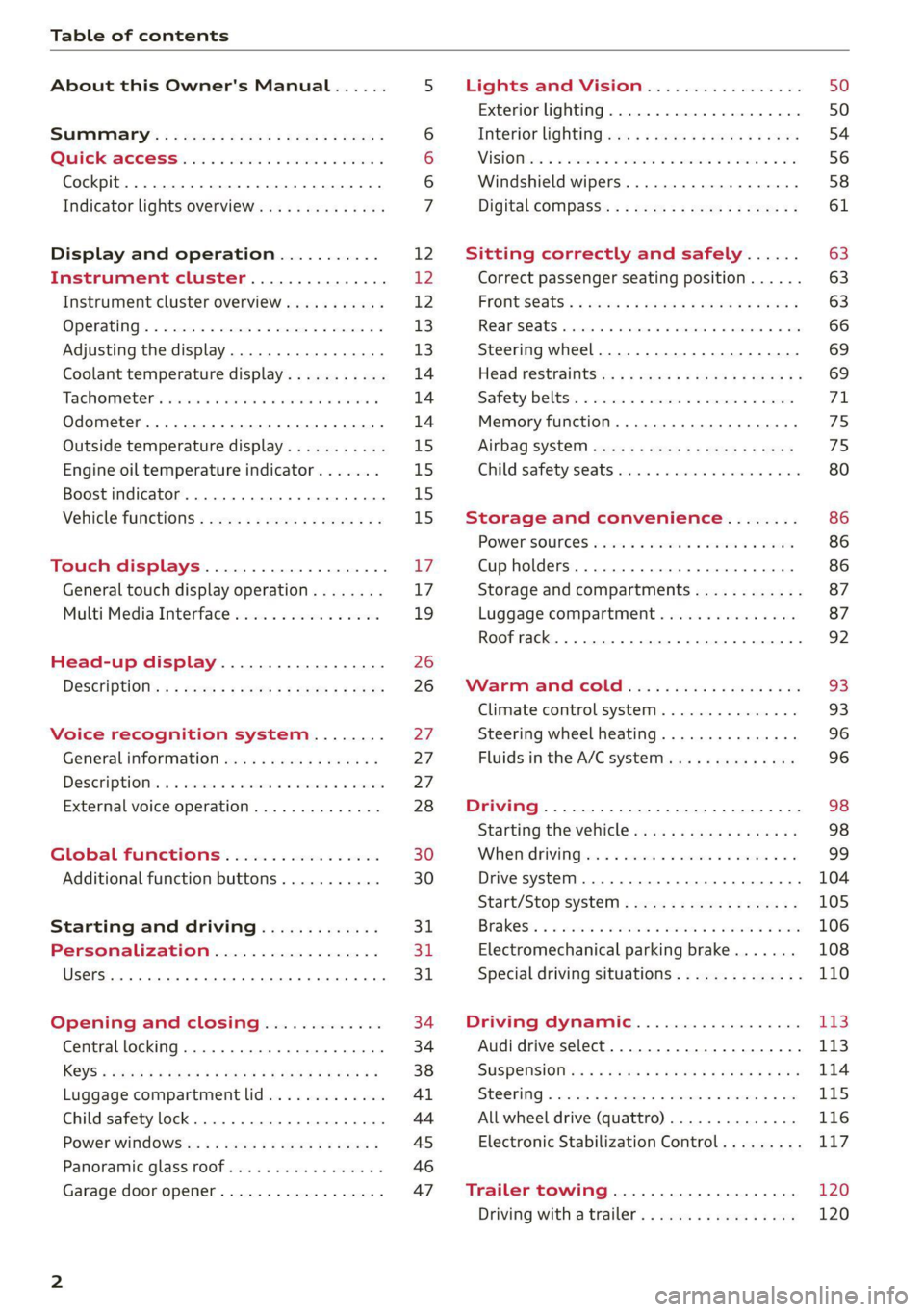
Table of contents
About this Owner's Manual......
SUMIMAry: < = exe : eens: Seen cs sens
QutckeaeCe ssh: «i esis se ois a eaves @
Cockpit. ...... 0... eee eee eee eee
Indicator lights overview...........4..
Display and operation...........
Instrument cluster...............
Instrument cluster overview...........
Operating. ecccuse w+ were oo wens oo ayes 9 ¥
Adjusting the display.................
Coolant temperature display...........
Tachometer’ series i ewe so snes ¥ & ome
Odometer.............. cee eee eee ee
Outside temperature display...........
Engine oil temperature indicator.......
Boost indicator...............0--000.
Vehicle functions...............-----
Touch displays....................
General touch display operation........
Multi Media Interface................
Head-up display..................
DeSeriptions: s wees « x wows ¢ cess so eee
Voice recognition system........
Generalinformation.................
DeSeriptions. «+ seams x x arucsms x 0 seine oo coer
External voice operation..............
Global FUNGtHIONS:. icc: 5 6 ese. 6 6 sce
Additional function buttons...........
Starting and driving.............
Personalization..................
Opening and closing.............
Central locking..............00-e eee
Child safety lock.............00.-000
Power WindOWSic« s < sews ys wey 5 2 em 5
Panoramic glass'roof seis ss sews se ewe ea
Garage door opener..................
NOD
OO
12 12 12
13
13
14 14 14
15
15
15
15
17 17 19
26
26
BY
27 27 28 30 30
31 31
311.
34
34
38
Al
44
45
46
Lights and Vision................. 50
Exterior lighting...............0000ee 50
Interior lightingissss « ¢ ews + ¢ ees es eee 54
MiSIOM iss +o seas os aroma oo ewe wo eS wars 56
Windshield wipers................05- 58
Digital compass’ « < sces ss sees sz wees ae 61
Sitting correctly and safely...... 63
Correct passenger seating position...... 63
PROMUSCStS: + wares x x nouns 6 e RawER ye eae 8 63
ReAarSeats verse a coecns oo area oo semen nw aie 66
Steering wheel.............2.200005. 69
Head restraintsts: « » gare x 2 oawa ys qe a 5 69
Safety belts..............00..00000. 71
Memory function............2..00 eee 75
Airbag syst@m aces ss cece se ees ee ees 75
Child safety seats cic «4 wessn « women © vane 80
Storage and convenience........ 86
POWer SOURCES sisson «+ women « ¥ oes 3 6 eos 86
Cup holders........ 00... e cece eee 86
Storage and compartments............ 87
Luggage compartment............... 87
Roof rack... 2.0... 0... eee eee eee eee 92
Warm and cold.................5. oe
Climate control system............... 93
Steering wheel heating............... 96
Fluids in the A/C system.............. 96
Driving................. 0.00.00 000. 98
Starting the vehicle. ..........eee cues 98
Whenrdrivingser. sess os eeu oe emcee ves 99
Drive system... 02... ee eee eee 104
Start/Stop System « ecw: se sees te sees de 105
Brakests «sais 2 wine 2 oem a 3 enon 2 o paws 106
Electromechanical parking brake....... 108
Special driving situations.............. 110
Driving dynamic.................. L3
Audi drive select...............00000. 113
SUSPENSION es « & saves ¥ & sie 9 & wares ov BE 114
SECOKIING « ccexscs 1 % ssewome w = wxwmome 6 a ceemTEE Hot 115
All wheel drive (quattro) .............. 116
Electronic Stabilization Control......... 117
Trailer towing.................... 120
Driving with atrailer................. 120
Page 65 of 332
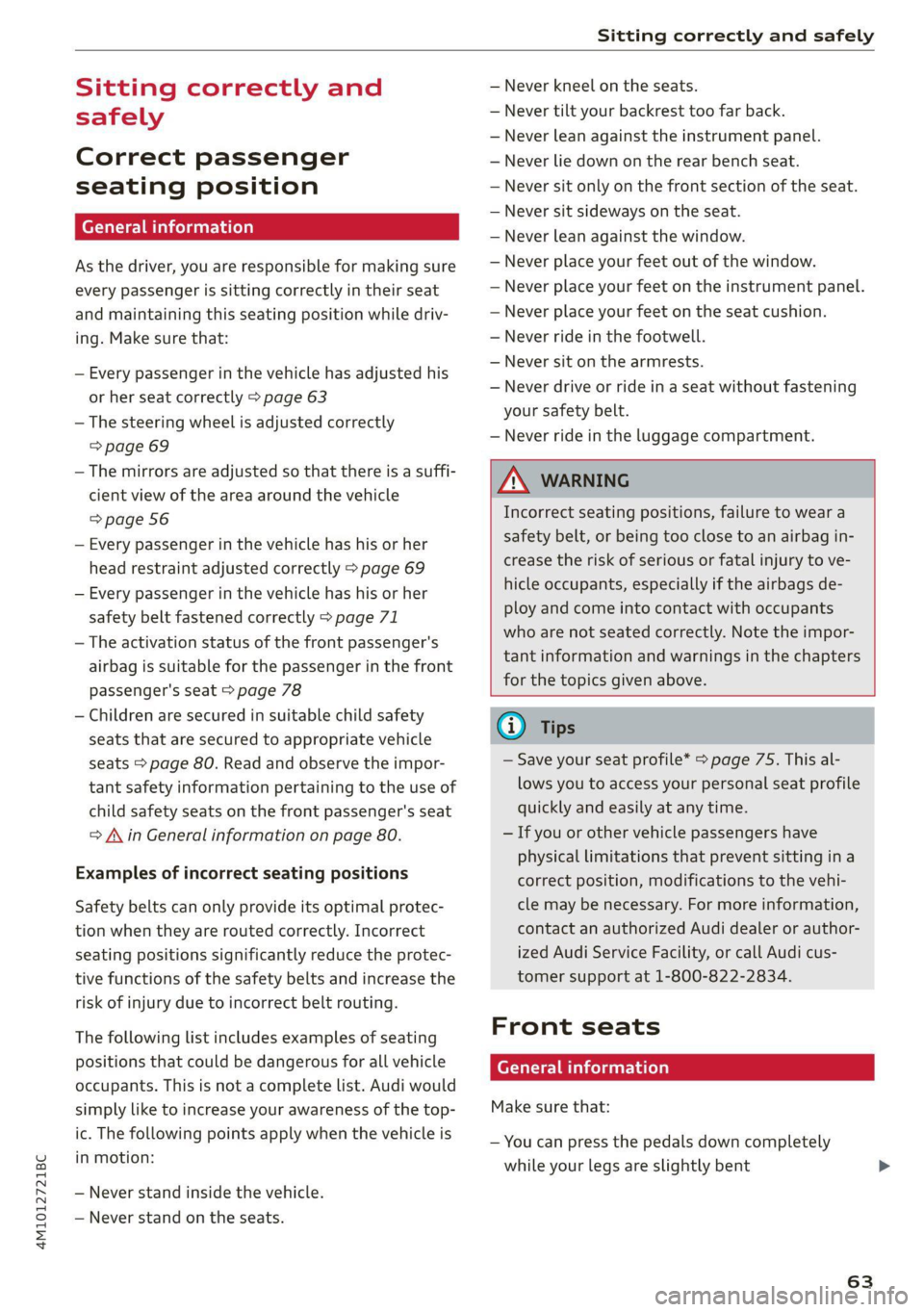
4M1012721BC
Sitting correctly and safely
Sitting correctly and
safely
Correct passenger
seating position
General information
As the driver, you are responsible for making sure
every passenger is sitting correctly in their seat
and maintaining this seating position while driv-
ing. Make sure that:
— Every passenger in the vehicle has adjusted his
or her seat correctly > page 63
— The steering wheel is adjusted correctly
=> page 69
— The mirrors are adjusted so that there is a suffi-
cient view of the area around the vehicle
=> page 56
— Every passenger in the vehicle has his or her
head restraint adjusted correctly > page 69
— Every passenger in the vehicle has his or her
safety belt fastened correctly > page 71
— The activation status of the front passenger's
airbag is suitable for the passenger in the front
passenger's seat > page 78
— Children are secured in suitable child safety
seats that are secured to appropriate vehicle
seats > page 80. Read and observe the impor-
tant safety information pertaining to the use of
child safety seats on the front passenger's seat
= A in General information on page 80.
Examples of incorrect seating positions
Safety belts can only provide its optimal protec-
tion when they are routed correctly. Incorrect
seating positions significantly reduce the protec-
tive functions of the safety belts and increase the
risk of injury due to incorrect belt routing.
The following list includes examples of seating
positions that could be dangerous for all vehicle
occupants. This is not a complete list. Audi would
simply like to increase your awareness of the top-
ic. The following points apply when the vehicle is
in motion:
— Never stand inside the vehicle.
— Never stand on the seats.
— Never kneel on the seats.
— Never tilt your backrest too far back.
— Never lean against the instrument panel.
— Never lie down on the rear bench seat.
— Never sit only on the front section of the seat.
— Never sit sideways on the seat.
— Never lean against the window.
— Never place your feet out of the window.
— Never place your feet on the instrument panel.
— Never place your feet on the seat cushion.
— Never ride in the footwell.
— Never sit on the armrests.
— Never drive or ride in a seat without fastening
your safety belt.
— Never ride in the luggage compartment.
ZA\ WARNING
Incorrect seating positions, failure to wear a
safety belt, or being too close to an airbag in-
crease the risk of serious or fatal injury to ve-
hicle occupants, especially if the airbags de-
ploy and come into contact with occupants
who are not seated correctly. Note the impor-
tant information and warnings in the chapters
for the topics given above.
Gi) Tips
— Save your seat profile* > page 75. This al-
lows you to access your personal seat profile
quickly and easily at any time.
— If you or other vehicle passengers have
physical limitations that prevent sitting ina
correct position, modifications to the vehi-
cle may be necessary. For more information,
contact an authorized Audi dealer or author-
ized Audi Service Facility, or call Audi cus-
tomer support at 1-800-822-2834.
Front seats
General information
Make sure that:
— You can press the pedals down completely
while your legs are slightly bent
63
Page 72 of 332
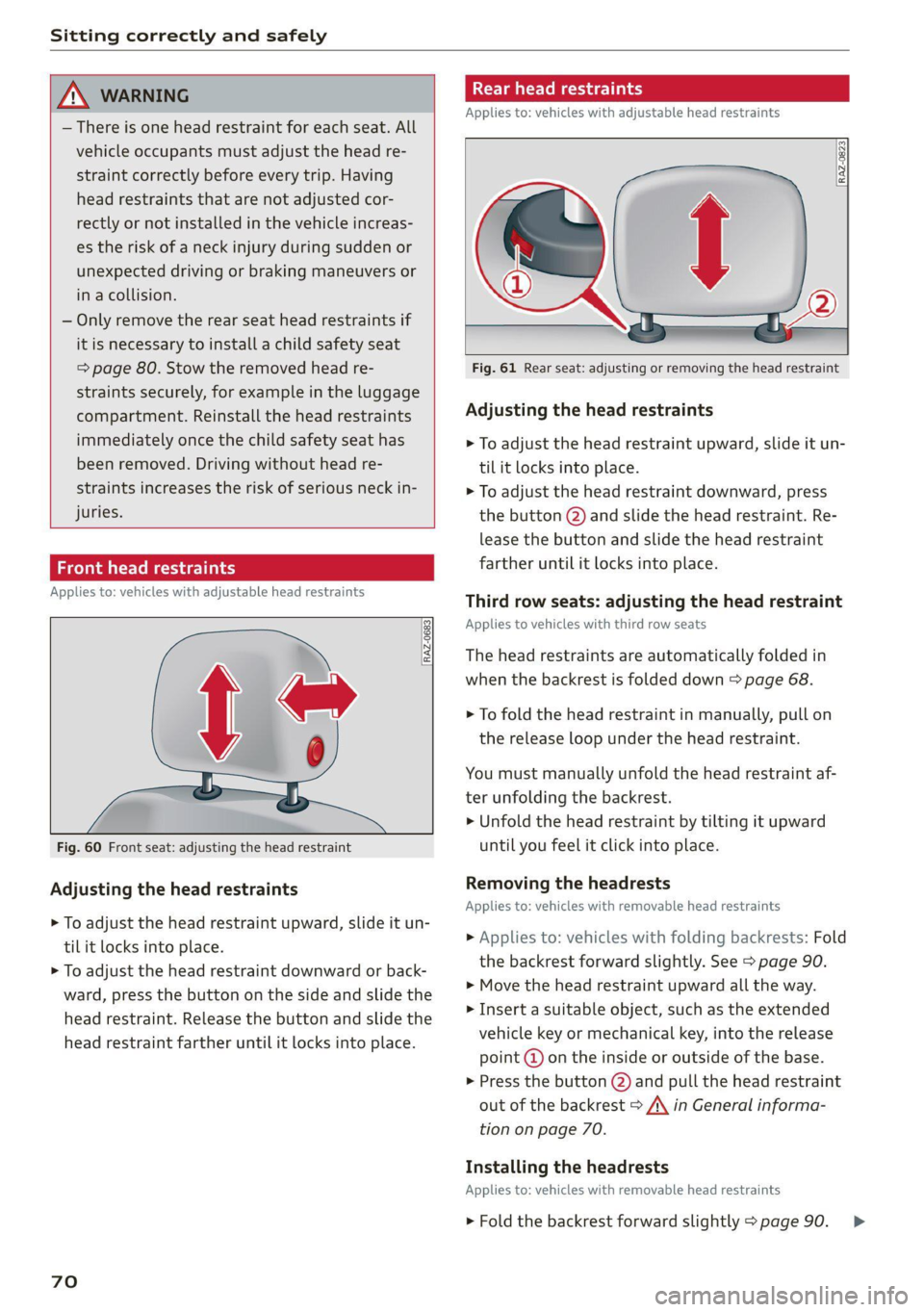
Sitting correctly and safely
ZA\ WARNING
— There is one head restraint for each seat. All
vehicle occupants must adjust the head re-
straint correctly before every trip. Having
head restraints that are not adjusted cor-
rectly or not installed in the vehicle increas-
es the risk of a neck injury during sudden or
unexpected driving or braking maneuvers or
in a collision.
— Only remove the rear seat head restraints if
it is necessary to install a child safety seat
= page 80. Stow the removed head re-
straints securely, for example in the luggage
compartment. Reinstall the head restraints
immediately once the child safety seat has
been removed. Driving without head re-
straints increases the risk of serious neck in-
juries.
ae memes)
Applies to: vehicles with adjustable head restraints
RAZ-0683,
Fig. 60 Front seat: adjusting the head restraint
Adjusting the head restraints
> To adjust the head restraint upward, slide it un-
til it locks into place.
> To adjust the head restraint downward or back-
ward, press the button on the side and slide the
head restraint. Release the button and slide the
head restraint farther until it locks into place.
70
Rear head restraints
Applies to: vehicles with adjustable head restraints
RAZ-0823
Fig. 61 Rear seat: adjusting or removing the head restraint
Adjusting the head restraints
> To adjust the head restraint upward, slide it un-
til it locks into place.
> To adjust the head restraint downward, press
the button @) and slide the head restraint. Re-
lease the button and slide the head restraint
farther until it locks into place.
Third row seats: adjusting the head restraint
Applies to vehicles with third row seats
The head restraints are automatically folded in
when the backrest is folded down > page 68.
> To fold the head restraint in manually, pull on
the release loop under the head restraint.
You must manually unfold the head restraint af-
ter unfolding the backrest.
> Unfold the head restraint by tilting it upward
until you feel it click into place.
Removing the headrests
Applies to: vehicles with removable head restraints
> Applies to: vehicles with folding backrests: Fold
the backrest forward slightly. See > page 90.
> Move the head restraint upward all the way.
> Insert a suitable object, such as the extended
vehicle key or mechanical key, into the release
point @ on the inside or outside of the base.
> Press the button (2) and pull the head restraint
out of the backrest > A\ in General informa-
tion on page 70.
Installing the headrests
Applies to: vehicles with removable head restraints
> Fold the backrest forward slightly > page 90. >
Page 73 of 332

4M1012721BC
Sitting correctly and safely
> Slide the posts on the head restraint down into
the guides until the posts click into place.
> Press the button @) and slide the head restraint
all the way down. It should not be possible to
remove the head restraint from the backrest
without pressing the button.
Safety belts
Each seat is equipped with a three-point safety
belt. Safety belts that are worn correctly are the
most effective way to reduce the risk of serious or
fatal injuries in a collision. Therefore, wear your
safety belt correctly and make sure that all vehi-
cle passengers are also wearing their safety belts
correctly when the vehicle is moving.
Even though your vehicle is equipped with an air-
bag system, every vehicle passenger must still al-
ways wear the appropriate safety belt. In addi-
tion to their normal protective function, safety
belts also hold vehicle occupants in the correct
seating position in the event of a collision so that
the airbags can deploy correctly and provide addi-
tional protection. Safety belts provide protection
during collisions when the airbags do not deploy
or if they have already deployed.
ZA WARNING
The risk of serious or fatal injury increases if
the safety belt is not fastened, if it is worn in-
correctly, or if it is damaged.
— All vehicle occupants, including the driver,
must fasten their safety belts correctly be-
fore every trip and must always keep their
safety belts fastened during the trip, regard-
less of whether the seat is equipped with an
airbag or not. This also applies to children
that are seated in a child safety seat that is
appropriate for their weight and age and
that is secured with a safety belt.
— In the event of a collision, vehicle occupants
that are not wearing safety belts could be
propelled through the vehicle interior and
collide with vehicle components, such as the
steering wheel, instrument panel, wind-
shield, or doors. In some situations, vehicle
occupants could also be ejected from the ve-
hicle. Vehicle occupants in the rear seats
who do not wear safety belts not only en-
danger themselves, but also other people in
the vehicle.
— Only one person may be fastened with a
safety belt at a time. Never secure more
than one person, including children, with a
single safety belt.
— Never allow children or infants to ride on an-
other person's lap and be belted into the
safety belt with them.
— Insert the belt buckle only in the belt latch
belonging to the corresponding seat, so that
the protective function is not impaired.
—To ensure the maximum protective function
of the safety belts, all vehicle passengers
must sit in the correct seating position
=> page 63.
— Check the condition of your vehicle’s safety
belts regularly > page 281. If you find dam-
age to the belt webbing, the belt connec-
tions, the retractor, or the buckle, have the
damaged safety belt replaced by an author-
ized Audi dealer or authorized Audi Service
Facility.
— The safety belts must not be removed or
modified in any way. Do not attempt to re-
pair the safety belts yourself.
— Safety belts that are strained during an acci-
dent must be replaced by an authorized
Audi dealer or authorized Audi Service Facili-
ty.
71
Page 83 of 332
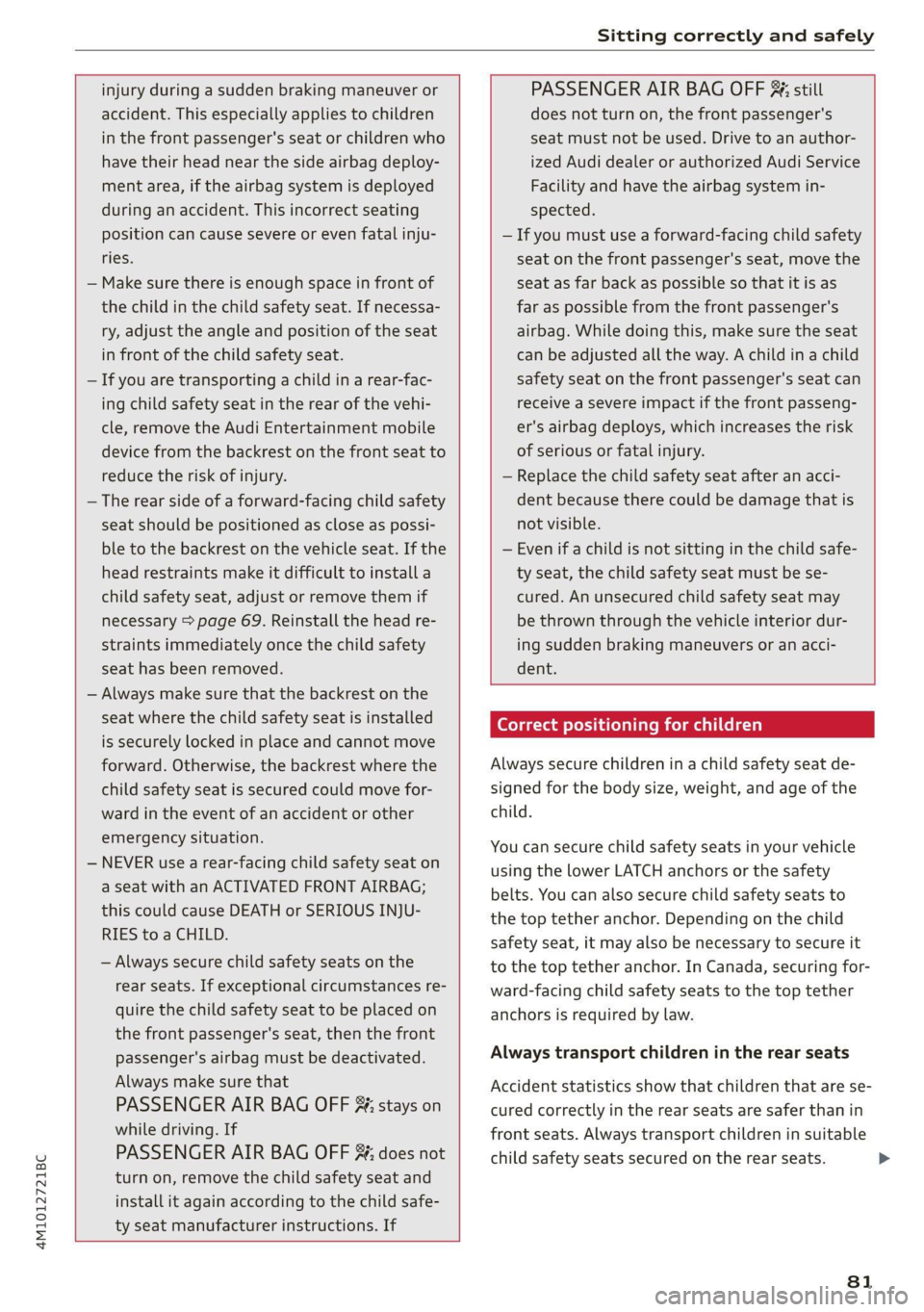
4M1012721BC
Sitting correctly and safely
injury during a sudden braking maneuver or
accident. This especially applies to children
in the front passenger's seat or children who
have their head near the side airbag deploy-
ment area, if the airbag system is deployed
during an accident. This incorrect seating
position can cause severe or even fatal inju-
ries.
Make sure there is enough space in front of
the child in the child safety seat. If necessa-
ry, adjust the angle and position of the seat
in front of the child safety seat.
If you are transporting a child in a rear-fac-
ing child safety seat in the rear of the vehi-
cle, remove the Audi Entertainment mobile
device from the backrest on the front seat to
reduce the risk of injury.
The rear side of a forward-facing child safety
seat should be positioned as close as possi-
ble to the backrest on the vehicle seat. If the
head restraints make it difficult to install a
child safety seat, adjust or remove them if
necessary > page 69. Reinstall the head re-
straints immediately once the child safety
seat has been removed.
Always make sure that the backrest on the
seat where the child safety seat is installed
is securely locked in place and cannot move
forward. Otherwise, the backrest where the
child safety seat is secured could move for-
ward in the event of an accident or other
emergency situation.
NEVER use a rear-facing child safety seat on
a seat with an ACTIVATED FRONT AIRBAG;
this could cause DEATH or SERIOUS INJU-
RIES to a CHILD.
— Always secure child safety seats on the
rear seats. If exceptional circumstances re-
quire the child safety seat to be placed on
the front passenger's seat, then the front
passenger's airbag must be deactivated.
Always make sure that
PASSENGER AIR BAG OFF %; stays on
while driving. If
PASSENGER AIR BAG OFF %, does not
turn on, remove the child safety seat and
install it again according to the child safe-
ty seat manufacturer instructions. If
PASSENGER AIR BAG OFF #; still
does not turn on, the front passenger's
seat must not be used. Drive to an author-
ized Audi dealer or authorized Audi Service
Facility and have the airbag system in-
spected.
— If you must use a forward-facing child safety
seat on the front passenger's seat, move the
seat as far back as possible so that it is as
far as possible from the front passenger's
airbag. While doing this, make sure the seat
can be adjusted all the way. A child in a child
safety seat on the front passenger's seat can
receive a severe impact if the front passeng-
er's airbag deploys, which increases the risk
of serious or fatal injury.
— Replace the child safety seat after an acci-
dent because there could be damage that is
not visible.
— Even if a child is not sitting in the child safe-
ty seat, the child safety seat must be se-
cured. An unsecured child safety seat may
be thrown through the vehicle interior dur-
ing sudden braking maneuvers or an acci-
dent.
Correct positioning for children
Always secure children in a child safety seat de-
signed for the body size, weight, and age of the
child.
You can secure child safety seats in your vehicle
using the lower LATCH anchors or the safety
belts. You can also secure child safety seats to
the top tether anchor. Depending on the child
safety seat, it may also be necessary to secure it
to the top tether anchor. In Canada, securing for-
ward-facing child safety seats to the top tether
anchors is required by law.
Always transport children in the rear seats
Accident statistics show that children that are se-
cured correctly in the rear seats are safer than in
front seats. Always transport children in suitable
child safety seats secured on the rear seats.
81
>
Page 85 of 332
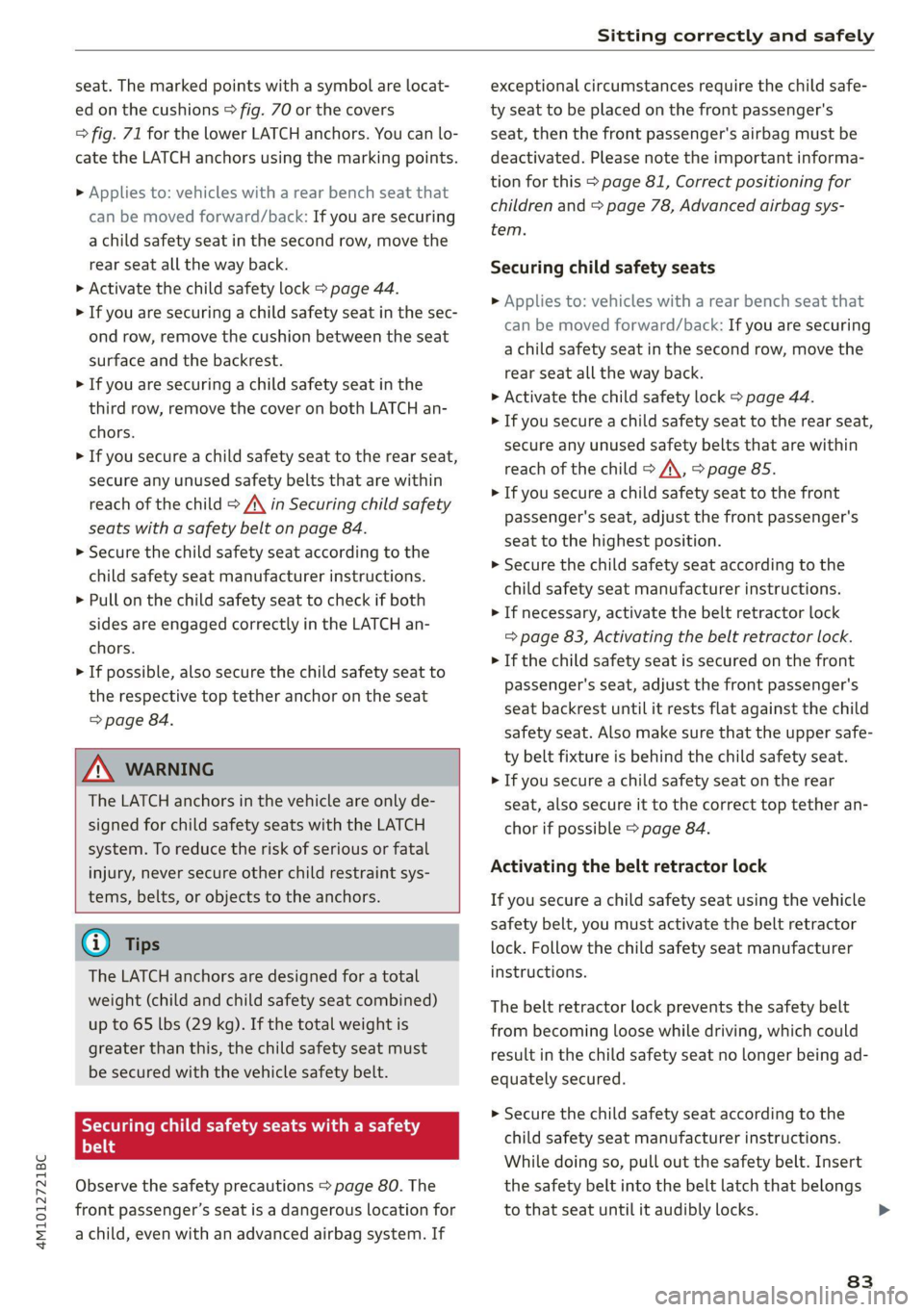
4M1012721BC
Sitting correctly and safely
seat. The marked points with a symbol are locat-
ed on the cushions > fig. 70 or the covers
=> fig. 71 for the lower LATCH anchors. You can lo-
cate the LATCH anchors using the marking points.
> Applies to: vehicles with a rear bench seat that
can be moved forward/back: If you are securing
a child safety seat in the second row, move the
rear seat all the way back.
> Activate the child safety lock > page 44.
> If you are securing a child safety seat in the sec-
ond row, remove the cushion between the seat
surface and the backrest.
> If you are securing a child safety seat in the
third row, remove the cover on both LATCH an-
chors.
> If you secure a child safety seat to the rear seat,
secure any unused safety belts that are within
reach of the child > A\ in Securing child safety
seats with a safety belt on page 84.
> Secure the child safety seat according to the
child safety seat manufacturer instructions.
> Pull on the child safety seat to check if both
sides are engaged correctly in the LATCH an-
chors.
> If possible, also secure the child safety seat to
the respective top tether anchor on the seat
=> page 84.
ZA WARNING
The LATCH anchors in the vehicle are only de-
signed for child safety seats with the LATCH
system. To reduce the risk of serious or fatal
injury, never secure other child restraint sys-
tems, belts, or objects to the anchors.
@) Tips
The LATCH anchors are designed for a total
weight (child and child safety seat combined)
up to 65 lbs (29 kg). If the total weight is
greater than this, the child safety seat must
be secured with the vehicle safety belt.
Securing child safety seats with a safety
belt
Observe the safety precautions > page 80. The
front passenger’s seat is a dangerous location for
a child, even with an advanced airbag system. If
exceptional circumstances require the child safe-
ty seat to be placed on the front passenger's
seat, then the front passenger's airbag must be
deactivated. Please note the important informa-
tion for this > page 81, Correct positioning for
children and > page 78, Advanced airbag sys-
tem.
Securing child safety seats
» Applies to: vehicles with a rear bench seat that
can be moved forward/back: If you are securing
a child safety seat in the second row, move the
rear seat all the way back.
> Activate the child safety lock > page 44.
> If you secure a child safety seat to the rear seat,
secure any unused safety belts that are within
reach of the child > A\, > page 85.
> If you secure a child safety seat to the front
passenger's seat, adjust the front passenger's
seat to the highest position.
>» Secure the child safety seat according to the
child safety seat manufacturer instructions.
> If necessary, activate the belt retractor lock
=> page 83, Activating the belt retractor lock.
> If the child safety seat is secured on the front
passenger's seat, adjust the front passenger's
seat backrest until it rests flat against the child
safety seat. Also make sure that the upper safe-
ty belt fixture is behind the child safety seat.
> If you secure a child safety seat on the rear
seat, also secure it to the correct top tether an-
chor if possible > page 84.
Activating the belt retractor lock
If you secure a child safety seat using the vehicle
safety belt, you must activate the belt retractor
lock. Follow the child safety seat manufacturer
instructions.
The belt retractor lock prevents the safety belt
from becoming loose while driving, which could
result in the child safety seat no longer being ad-
equately secured.
> Secure the child safety seat according to the
child safety seat manufacturer instructions.
While doing so, pull out the safety belt. Insert
the safety belt into the belt latch that belongs
to that seat until it audibly locks.
83
>
Page 86 of 332
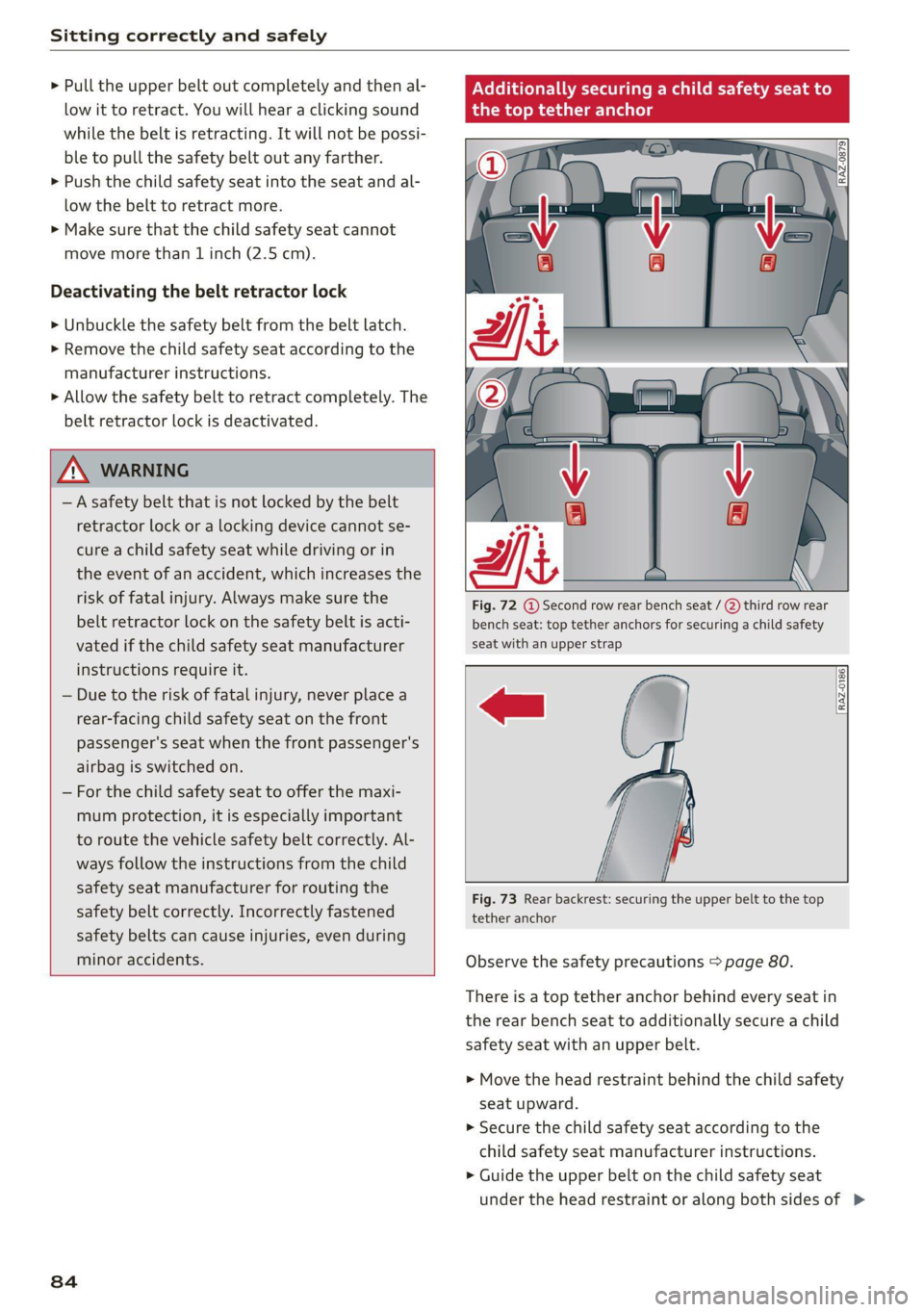
Sitting correctly and safely
> Pull the upper belt out completely and then al-
low it to retract. You will hear a clicking sound
while the belt is retracting. It will not be possi-
ble to pull the safety belt out any farther.
> Push the child safety seat into the seat and al-
low the belt to retract more.
> Make sure that the child safety seat cannot
move more than 1 inch (2.5 cm).
Deactivating the belt retractor lock
> Unbuckle the safety belt from the belt latch.
> Remove the child safety seat according to the
manufacturer instructions.
> Allow the safety belt to retract completely. The
belt retractor lock is deactivated.
Aw
—A safety belt that is not locked by the belt
retractor lock or a locking device cannot se-
cure a child safety seat while driving or in
the event of an accident, which increases the
risk of fatal injury. Always make sure the
belt retractor lock on the safety belt is acti-
vated if the child safety seat manufacturer
instructions require it.
— Due to the risk of fatal injury, never place a
rear-facing child safety seat on the front
passenger's seat when the front passenger's
airbag is switched on.
— For the child safety seat to offer the maxi-
mum protection, it is especially important
to route the vehicle safety belt correctly. Al-
ways follow the instructions from the child
safety seat manufacturer for routing the
safety belt correctly. Incorrectly fastened
safety belts can cause injuries, even during
minor accidents.
bench seat: top tether anchors for securing a child safety
seat with an upper strap
RAZ.0186)
84
Fig. 73 Rear backrest: securing the upper belt to the top
tether anchor
Observe the safety precautions > page 80.
There is a top tether anchor behind every seat in
the rear bench seat to additionally secure a child
safety seat with an upper belt.
> Move the head restraint behind the child safety
seat upward.
> Secure the child safety seat according to the
child safety seat manufacturer instructions.
> Guide the upper belt on the child safety seat
under the head restraint or along both sides of >
Page 87 of 332

4M1012721BC
Sitting correctly and safely
it and toward the rear (depending on the child
safety seat model).
> Fasten the belt to the top tether anchor
> fig. 73. While doing this, make sure the belt
is not twisted and is not running over any sharp
edges.
> Pull the belt tightly so that the child safety seat
rests at the top of the seat backrest.
» If necessary, move the head restraint behind
the child safety seat downward.
> Activate the belt retractor lock on the fastened
safety belts. To do this, pull the upper belt out
completely and then allow it to retract. You will
hear a clicking sound while the belt is retract-
ing. It will not be possible to pull the safety
belt out any farther.
>» Make sure the fastened safety belt does not
block access to the LATCH anchors. Otherwise,
it may not be possible to secure the child safety
seat to the LATCH anchors correctly.
Z\ WARNING
The top tether anchors in the vehicle are only
designed for child safety seats equipped with
an upper strap. To reduce the risk of serious or
fatal injury, never secure other child restraint
systems, belts, or objects to the anchors.
Yate emo Rt 1am nem Te
rtrd
Fig. 74 Second row rear bench seat: securing safety belts
that are not used
If a child safety seat is used on the rear bench
seat, the child must not be able to reach any
safety belts that are not being used. Secure safe-
ty belts that are within reach of the child.
> If you secure a child safety seat to the LATCH
anchors in the second row, fasten the safety
belt on the seat where the child safety seat is
installed using the seat's safety belt latch.
> If you secure a child safety seat to the LATCH
anchors in the third row, fasten the safety belt
on the seat where the child safety seat is instal-
led using the seat's safety belt latch.
> If you secure a child safety seat to one of the
outer seats in the second row, fasten the safety
belt for the center seat in its latch.
ZA\ WARNING
A child in a child safety seat could play with
the unused safety belts and then become en-
tangled in them, which increases the risk of
fatal injury. Always secure unused safety belts
so that they are not within reach of children in
child safety seats.
8s
Page 90 of 332
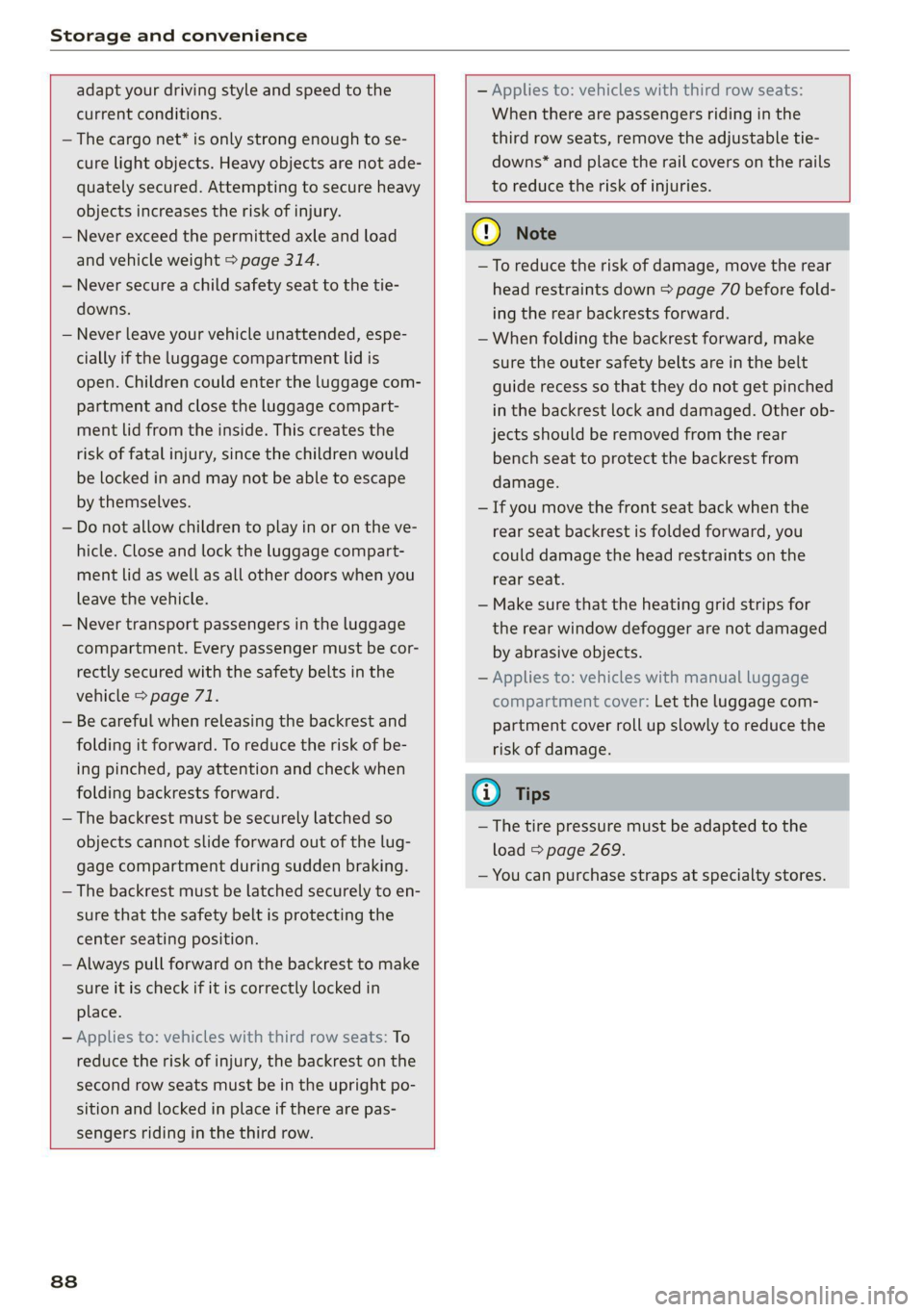
Storage and convenience
adapt your driving style and speed to the
current conditions.
— The cargo net* is only strong enough to se-
cure light objects. Heavy objects are not ade-
quately secured. Attempting to secure heavy
objects increases the risk of injury.
— Never exceed the permitted axle and load
and vehicle weight > page 314.
— Never secure a child safety seat to the tie-
downs.
— Never leave your vehicle unattended, espe-
cially if the luggage compartment lid is
open. Children could enter the luggage com-
partment and close the luggage compart-
ment lid from the inside. This creates the
risk of fatal injury, since the children would
be locked in and may not be able to escape
by themselves.
— Do not allow children to play in or on the ve-
hicle. Close and lock the luggage compart-
ment lid as well as all other doors when you
leave
the vehicle.
— Never transport passengers in the luggage
compartment. Every passenger must be cor-
rectly secured with the safety belts in the
vehicle > page 71.
— Be careful when releasing the backrest and
folding
it forward. To reduce the risk of be-
ing pinched, pay attention and check when
folding backrests forward.
— The backrest must be securely latched so
objects cannot slide forward out of the lug-
gage compartment during sudden braking.
— The backrest must be latched securely to en-
sure that the safety belt is protecting the
center seating position.
— Always pull forward on the backrest to make
sure it is check if it is correctly locked in
place.
— Applies to: vehicles with third row seats: To
reduce the risk of injury, the backrest on the
second row seats must be in the upright po-
sition and locked in place if there are pas-
sengers riding in the third row.
— Applies to: vehicles with third row seats:
When there are passengers riding in the
third row seats, remove the adjustable tie-
downs* and place the rail covers on the rails
to
reduce the risk of injuries.
88
C) Note
—To reduce the risk of damage, move the rear
head restraints down > page 70 before fold-
ing the rear backrests forward.
— When folding the backrest forward, make
sure the outer safety belts are in the belt
guide recess so that they do not get pinched
in the backrest lock and damaged. Other ob-
jects should be removed from the rear
bench seat to protect the backrest from
damage.
— If you move the front seat back when the
rear seat backrest is folded forward, you
could damage the head restraints on the
rear seat.
— Make sure that the heating grid strips for
the rear window defogger are not damaged
by abrasive objects.
— Applies to: vehicles with manual luggage
compartment cover: Let the luggage com-
partment cover roll up slowly to reduce the
risk of damage.
(i) Tips
—The tire pressure must be adapted to the
load > page 269.
— You can purchase straps at specialty stores.
Page 326 of 332
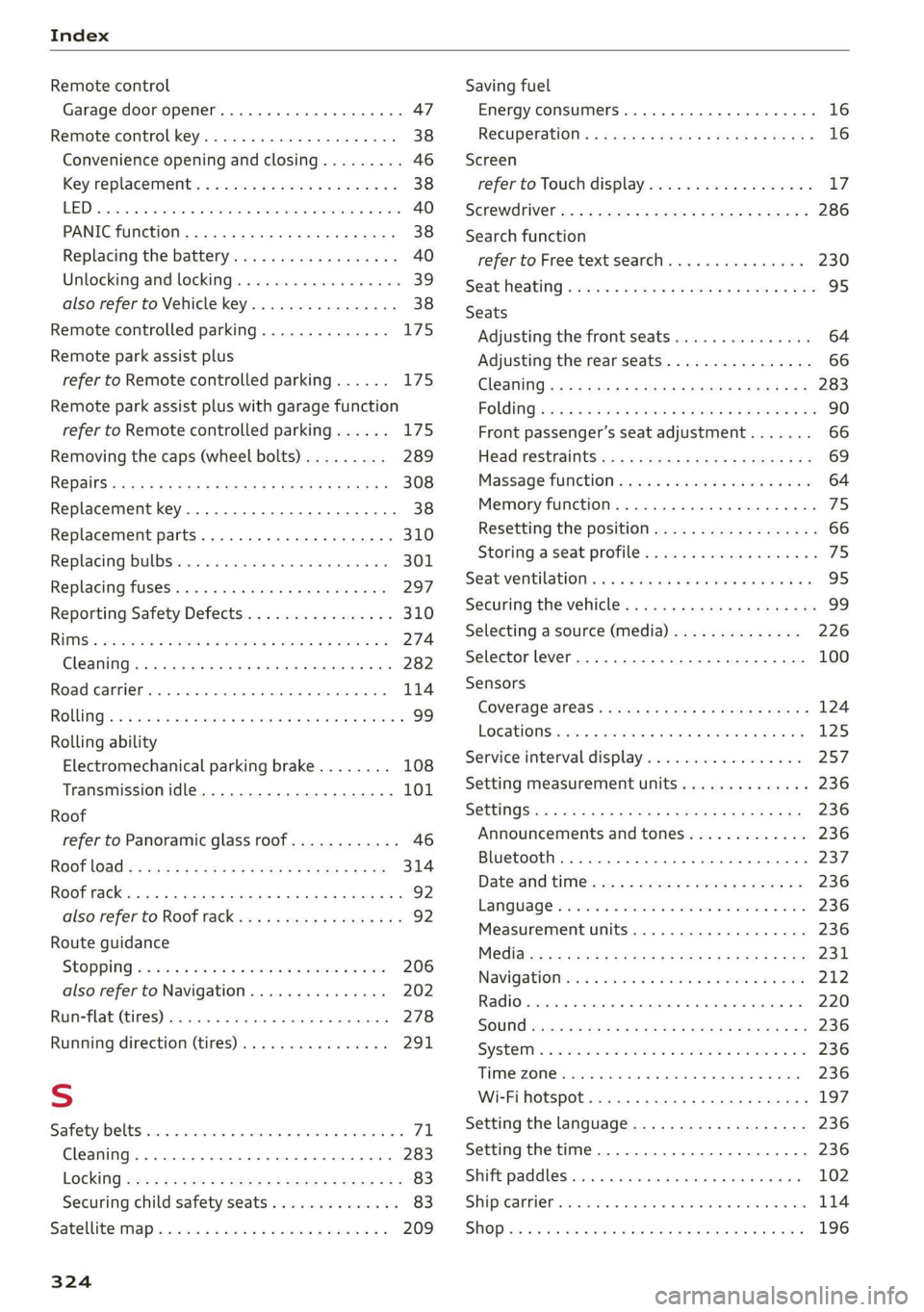
Index
Remote control
Garage door opener........... eee eens 47
Remote control key............02-000005 38
Convenience opening and closing......... 46
Key replacement...............-.00005 38
a 40
PANIC function ..............000 0000 ee 38
Replacingthe battery cos « « warns x ¢ saves @ es 40
Unlocking and locking................0- 39
also refer to Vehicle key............000. 38
Remote controlled parking.............. 175
Remote park assist plus
refer to Remote controlled parking...... 175
Remote park assist plus with garage function
refer to Remote controlled parking...... 175
Removing the caps (wheel bolts)......... 289
REDOINS sav ¢ mavas & § Sein se BeOS «Saree Gs 308
Replacement key............00 0c e eee 38
Replacement partS...........-0 eee eee 310
Replacing bulbs................0000005 301
Replacing fusesi. . « asic. «sme & «i mere « 5 en 297
Reporting
Safety Defects................ 310
RIMS%s con oo eases oe eee ot eee 2 eee 274
Cleaning... . eee ee eee eee eee ee 282
ROAGiGANRGIER sesso + ences wo nee wo emo & oe HO 114
ROU «owns oe ewes 6s ene oe mae oo ee 99
Rolling
ability
Electromechanical parking brake........ 108
Transmission idle..................00. 101
Roof
refer to Panoramic glass roof............ 46
ROOFIOS « = esis ¢ o cen ¢ Hates & & Hee & Eee 314
Roof rack... eee eee eee 92
also refer to Roof rack. .........-eeeeeee 92
Route guidance
SEOPPING swvsas ov seeauee 6 v seus wo sxaweve vo sume 206
also refer to Navigation............... 202
Run-flat (tires)... eee eee 278
Running direction (tires)................ 291
S
Safety beltSiesces 2 x aces vw cece < wens wv ene & 71
Cleaning............. 6.6 c ee eee eee eee 283
LOCKINGiwes = s cous = = oes 2 2 eee go eee ge 83
Securing child safety seats.............. 83
Satellite map « sess = mea 2 ewes 2 wasn © 209
324
Saving fuel
Energy consumers ...... 0.0020 s cece eee 16
REGUPERAtION s + nase + meee x mew eG ReveD 8 16
Screen
refer to Touch display................-. 17
Screwdriver v. + 2 sss ¢ ¢ sees oe eas ee pee = 286
Search function
refer to Free text search............... 230
Seat Heating s scsia ow sscnve v warm ov seme a a ome 95
Seats
Adjusting the front seats............... 64
Adjusting the rear seats................ 66
GCleSniNG ie « ¢ same x e aes x oe a a eR EEE 283
FOUGING secs «a eserens wo wenecs «a anew WH reese 90
Front passenger’s seat adjustment....... 66
Head restraints...............222-000- 69
Massage function wives. eves ee een ev ees 64
Memory function.............0 eee eee 75
Resetting the position.................. 66
Storing aseat profile................... 75
Seat ventilation acs « ¢ same so eaves yo saws es 95
Securing the vehicles « css < pass ee news se xe 99
Selecting a source (media).............. 226
Selector lever...............00 00 cece 100
Sensors
Coverage areas « esis ie ves se eden cee s 124
WOCALIONS esas 3 + snovsus 2 + suwsaee 0 o execute 2 a comet 125
Service interval display................. 257
Setting measurement units.............. 236
S@ttiniGSias = « meay < & wee « eee 2 gamR se BE 236
Announcements and tones............. 236
Bluetooth. ......... 0... eee eee eee 237
Dat@ dnd time@ys: : 2 ewes 2 2 sees ee wenn ss 236
LANQUAGE & sicess os & smacess 9 & ieawens & & rae v & aes 236
Measurement units................... 236
Medidioz ¢ 5 smun § 5 cea & HameG & i RaeE ga eR 231
NavigatiOtticess + wes + savin so amas « % comem 212
Radio... eee cece eee eee 220
SOONG sassx z < saws ¢ 2 Bae FB Ree eB RRA GS 236
SYSt@Ms <2 wees 2 2 acne 2 2 arene yo ee 2 8 oe 236
TIME ZONE... ee eee 236
Wi-Fi hotspot..............02-.00000- 197
Setting the language................... 236
Setting the time...............-.00000- 236
Shift paddles........... 0. eee eee 102
Shipseanrier's + scaeve s wees © woven a ares o o ane 114
SHOPlice: so nessa + nese 2 eae 2 HaMeG ae BRIN 196